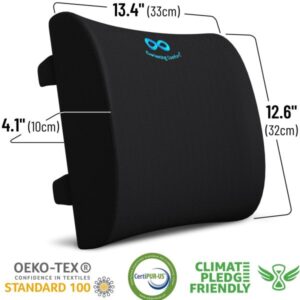Choosing the Best Back Pain Pillows for Chairs
Back pain can be a debilitating condition, but it is also a condition that can usually be managed with proactive pain relief, good posture and effective lumbar supports as back pain pillows for chairs. Using a pillow to support your spine when you are sitting in a chair can greatly your reduce back pain.

There are many types of pillows for chairs. The most common types include simple, affordable inflatable back supports, contour back pillows that support the entire spine, and foam back pillows. In addition, there are seat cushions that can help while you are sitting, and seat wedges which tilt your pelvis forwards, naturally encouraging better posture.
Good back support pillows conforms to your spine. Instead of simply letting you slouch back into your chair it encourages you to keep the lumbar spine in neutral spinal alignment.
You may need to test several different kinds of back pillow to find one that works for your condition. Memory foam pillows tend to last a long time, while cheaper soft foam pillows may need replacing often. Inflatable pillows are good for people who travel a lot, but are not always as comfortable or as effective as a high quality memory foam pillow for someone who has severe, chronic back pain.
It is a good idea to look at several back pain pillows for chairs, until you find one that suits your personal circumstances. The best back pain pillows for chairs will differ depending on where in your back the pain is, the type of chair you use, and whether you are sitting upright to type at your desk, or leaning back to read or relax. Your posture when sitting makes a big difference to the parts of your back that are under strain at any given time. Proper ergonomics can maximize results or even decrease the need for supports.
A study in the 2014 European Spine Journal used MRI to determine factors that influence lumbar spine disc degeneration and found having a greater lumbar curve was found to be protective for degeneration. A proper back support can help maintain this normal curve with proper back posture and protect the back from pain.
- If you are sitting for long periods, you should remember to stretch the hamstring muscles. Hamstring tightness disrupts the normal spine, pelvis and leg alignment, altering lumbar–pelvic rhythm and lead to compensation motions when bending and reaching, allowing excessive lumbar tissue and disc loading.







